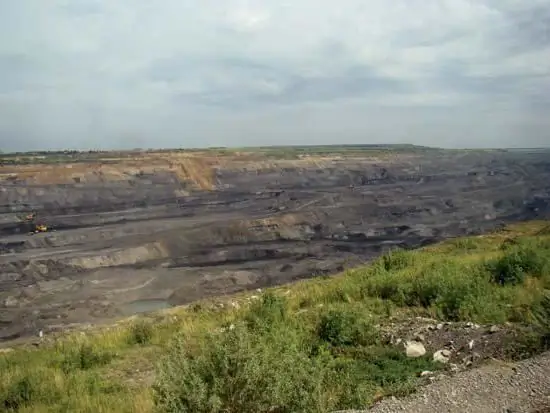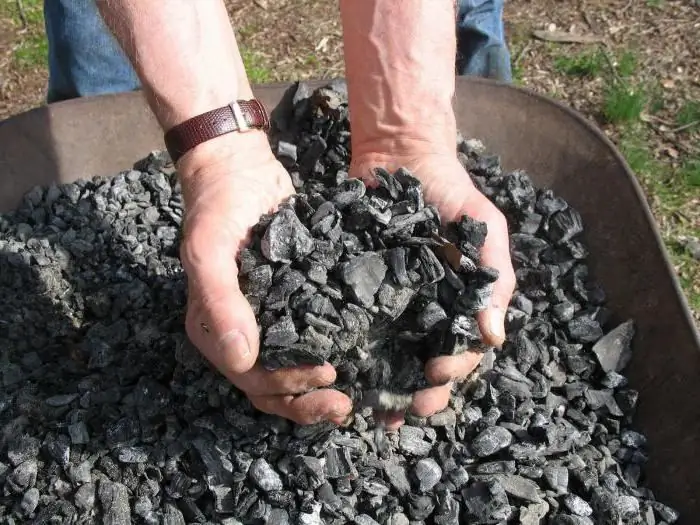2025 Author: Howard Calhoun | [email protected]. Last modified: 2025-01-24 13:10:29
Many will be able to recall the numerous crises that occurred in the coal industry in the late eighties and early nineties of the last century, associated with a drop in demand for coal and an increase in the unprofitability of the respective enterprises. The Ruhr coal basin became one of the centers of this kind of tension that arose between miners, big businessmen and the authorities. All world regions in which the coal industry was the main one entered a period of stagnation. However, this turn of events had an unexpected continuation.

Ruhr coal basin. Quick reference
The coal basin, located in the course of the Lower Rhine and the Ruhr River, deserves a separate story because of its huge volume. It ranks first in Western Europe in terms of the amount of stored coal.
Most of the territory of the basin is located on the left bank of the Lower Rhine, in the course of such rivers as the Ruhr, Escher and Lippe. And only a small part of the reserves is located on the right bank.

The total area of the basin exceeds 4,500 square kilometers, and its length from west to east is more than 140 kilometers. At the same time, the depth of occurrence of high-calorific coals does not exceed two thousand meters. More than 213 billion tons of coal are expected to lie within this horizon.
The vast majority of the coal reserves of the Ruhr coal basin were formed in the Carboniferous period, but there are also later stratifications and overthrusts. The coal basin of the Ruhr River is also considered one of the most productive, since there are over two hundred coal seams in the productive stratum, each of which has a thickness of half a meter. However, there are also such layers, the working thickness of which exceeds one meter. Coal is characterized by high fat content and good coking capacity, as well as high optimal combustion temperature.
Ruhr area. Essay
For the first time, the occurrence of significant coal reserves in the Rhine and Ruhr valley became known back in the XIII century, at that time the first large centers of trade and crafts arose.
The Ruhr coal basin is located in the federal state of North Rhine-Westphalia, with a population of more than five million three hundred thousand people. On the territory of this land is the largest urban agglomeration in Europe, the core of which are two large cities - Dortmund and Essen.
In modern economic geography, the Ruhr area is understood as a regional union of fifteen cities and districts called "Ruhr".
However, among scientists it is also often usedthe term conurbation, which is understood as an economically and transport interconnected network of cities, which includes not only the lands of North Rhine-Westphalia, but also Düsseldorf and Cologne. In this case, the population of the conurbation can reach twelve million people. Thus, the Ruhr coal basin is located on the territory of the most densely populated and highly urbanized part of Western Europe.

Ruhr conflict
In the 1920s, the natural resources of the Ruhr Basin in Germany were still important to the European economy and therefore caused a serious political conflict between the post-war Weimar Republic and the troops of the victorious countries in World War I.
The reason for the conflict was that after the First World War, Germany had to pay significant reparations in money and resources, but quite often there were interruptions or delays, since the economic situation in Germany itself was not the most stable.

French occupation
Responding to delays, the French president sent his country's troops into territories that had not previously been occupied. In 1921, French troops occupied the cities of Düsseldorf and Duisburg, which created all the necessary conditions for the occupation of the rest of the territory of the vast industrial region of Rhine-Westphalia.
Such an aggressive behavior of the French Republic clearly shows how important in post-war Europe wereminerals of the Ruhr basin. In large quantities, not only coal was produced in the region, but also steel, which the developing France so badly needed.
The entry of French troops caused a wave of indignation among the local population and served as a cause for riots. It is assumed that it was the behavior of French politicians that provoked the interest of the Germans in the National Socialist ideology.

Structural transformations
However, in the 1950s of the twentieth century, the so-called coal crisis broke out in Europe, which led to significant negative consequences for the labor market. Following the coal crisis, the steel crisis flared up, which also led to a drop in demand not only for steel, but also for coal.
As a result of almost two decades of ongoing economic recession, it has become clear that the economy of the Ruhr coal basin needs serious modernization, diversification and moving away from the raw material model.
In addition to the global economic crisis, an important reason for the decline in the local economy was the fact that mines with easily accessible coal were depleted, and new ones were no longer competitive in the international market.

Post-industrial future
According to statistics, from 1980 to 2002, more than five hundred thousand jobs were eliminated in the region, while no more than three hundred thousand were created. It is worth noting that painful structural changes have been taking place in the economy all this time. If amainly raw materials enterprises and coal mines were closed, then jobs were created in new industrial or post-industrial areas.
In two decades, numerous small and medium-sized enterprises have been opened in the fields of mechanical engineering, finance, electrical engineering and the service sector. Significant funds have been invested in enterprises serving the field of computer technology.

Administrative unit of the region
All resources that were mined in the Ruhr basin ceased to be of key importance in the European economy, but intellectual and human resources, the development of which in Germany was of great importance, came to the fore.
One of the most important features of the Ruhr region is its administrative structure. From an economic and administrative point of view, the Ruhr agglomeration is a polycentric city, since all the cities attributed to it are not separated by significant gaps.
In addition, a well-developed transport system allows you to easily get from one part of the city district to another with minimal time.
The fall of the region's economy provoked a decline in real estate prices, which led to the transfer of offices of large corporations to this urban area. Today, such large concerns as RAG, Degussa, ThyssenKrupp have head offices and a significant part of the production.
However, despite all the attempts of the authorities and business to stimulate economic growth in the region, itremains conjuncturally weak. Unemployment in the Ruhr area is more than 13%, which is the highest among the regions of West Germany. However, the region cannot be called depressive either.

Culture of the Ruhr Region
The Ruhr Basin, home to numerous non-functioning enterprises due to a rich industrial past, became the place where modern culture flourished at the end of the 20th century.
Local and federal authorities, seeking to give a new impetus to the development of the suffering region, decided to invest heavily in the development of the cultural environment in the region.
Today, the Ruhr Coal Basin is home to three world-famous major opera houses, ten theater venues and numerous art and history museums.
A major music festival is held annually in the region, during which 50 to 80 classical music concerts are held in the city district. In addition, philharmonic societies and concert halls at conservatories work on a permanent basis.
Education
A distinctive feature of the Ruhr urban region is the highest student population density in Germany. There are twenty-two institutions of higher education on the territory of the Ruhr Basin, seventeen of which are universities. It is in the Ruhr that the famous art academy Folkwang is located.
The largest university in the region is the Ruhr University Bochum, which has more than42 thousand students, including 7000 foreign students. Despite its size and importance to the German education system, the university was only founded in 1962.
Recommended:
Moscow region coal basin - history, features and interesting facts

Mining is an industry that has been developing for a very, very long time. One of the rather old deposits is the Podmoskovny coal basin
Coal: mining in Russia and in the world. Places and methods of coal mining

The coal mining industry is the largest segment of the fuel industry. Every year, the level of coal production increases all over the world, new technologies are mastered, equipment is improved
Brown coal. Coal mining. Brown coal deposit

The article is about brown coal. The features of the rock, the nuances of production, as well as the largest deposits are considered
Coal: properties. Hard coal: origin, production, price

Since ancient times, mankind has been using coal as one of the sources of energy. And today this mineral is used quite widely
Lena coal basin: geographical location, characteristics of reserves, methods of extraction

This article describes the Lena coal basin. It is one of the largest in the world in terms of the volume of coal deposited in it. But at the moment it is poorly exploited due to its remoteness, but this does not make it less interesting to study

